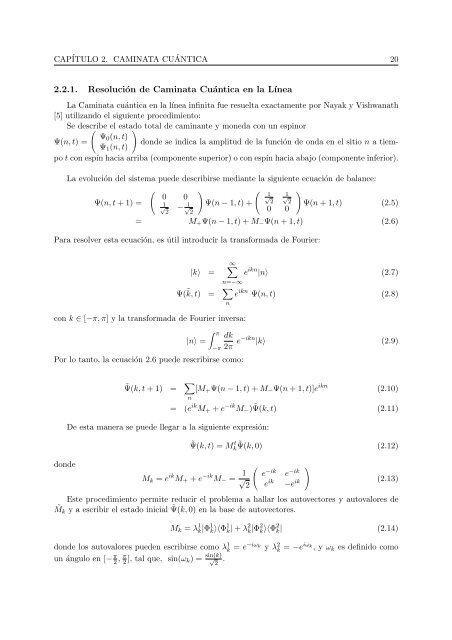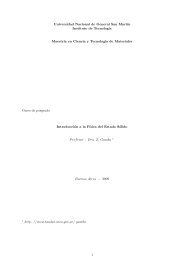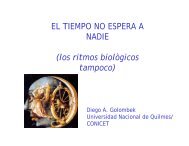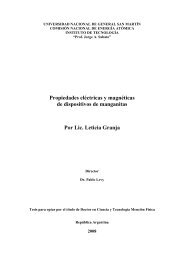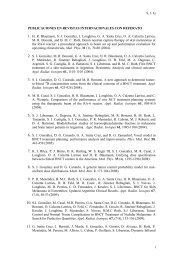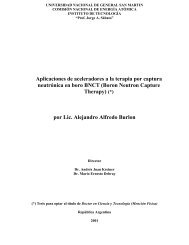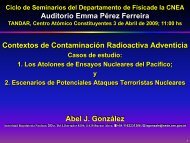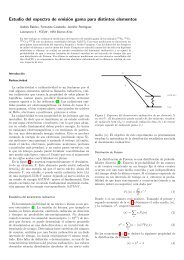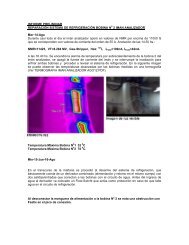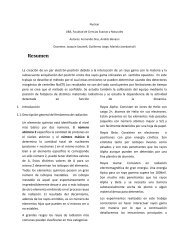Familia de Mapas del Panadero Como Ambiente Caótico de la ...
Familia de Mapas del Panadero Como Ambiente Caótico de la ...
Familia de Mapas del Panadero Como Ambiente Caótico de la ...
Create successful ePaper yourself
Turn your PDF publications into a flip-book with our unique Google optimized e-Paper software.
CAPÍTULO 2. CAMINATA CUÁNTICA 20<br />
2.2.1. Resolución <strong>de</strong> Caminata Cuántica en <strong>la</strong> Línea<br />
La Caminata cuántica en <strong>la</strong> línea infinita fue resuelta exactamente por Nayak y Vishwanath<br />
[5] utilizando el siguiente procedimiento:<br />
Se <strong>de</strong>scribe el estado total <strong>de</strong> caminante y moneda con un espinor<br />
Ψ0(n, t)<br />
Ψ(n, t) =<br />
don<strong>de</strong> se indica <strong>la</strong> amplitud <strong>de</strong> <strong>la</strong> función <strong>de</strong> onda en el sitio n a tiem-<br />
Ψ1(n, t)<br />
po t con espín hacia arriba (componente superior) o con espín hacia abajo (componente inferior).<br />
La evolución <strong>de</strong>l sistema pue<strong>de</strong> <strong>de</strong>scribirse mediante <strong>la</strong> siguiente ecuación <strong>de</strong> ba<strong>la</strong>nce:<br />
Ψ(n, t + 1) =<br />
<br />
0 0<br />
<br />
<br />
Ψ(n − 1, t) +<br />
√2 1<br />
<br />
Ψ(n + 1, t) (2.5)<br />
√1 −<br />
2 1 √<br />
2<br />
1<br />
√ 2<br />
0 0<br />
= M+Ψ(n − 1, t) + M−Ψ(n + 1, t) (2.6)<br />
Para resolver esta ecuación, es útil introducir <strong>la</strong> transformada <strong>de</strong> Fourier:<br />
|k〉 =<br />
∞<br />
n=−∞<br />
con k ∈ [−π, π] y <strong>la</strong> transformada <strong>de</strong> Fourier inversa:<br />
e ikn |n〉 (2.7)<br />
Ψ(k, ˜ t) = <br />
e ikn Ψ(n, t) (2.8)<br />
|n〉 =<br />
π<br />
Por lo tanto, <strong>la</strong> ecuación 2.6 pue<strong>de</strong> rescribirse como:<br />
don<strong>de</strong><br />
−π<br />
n<br />
dk<br />
2π e−ikn |k〉 (2.9)<br />
˜Ψ(k, t + 1) = <br />
[M+Ψ(n − 1, t) + M−Ψ(n + 1, t)]e ikn<br />
De esta manera se pue<strong>de</strong> llegar a <strong>la</strong> siguiente expresión:<br />
n<br />
(2.10)<br />
= (e ik M+ + e −ik M−) ˜ Ψ(k, t) (2.11)<br />
˜Ψ(k, t) = M t k ˜ Ψ(k, 0) (2.12)<br />
Mk = e ik M+ + e −ik M− = 1 √ 2<br />
<br />
e −ik e −ik<br />
e ik −e ik<br />
<br />
(2.13)<br />
Este procedimiento permite reducir el problema a hal<strong>la</strong>r los autovectores y autovalores <strong>de</strong><br />
˜Mk y a escribir el estado inicial ˜ Ψ(k, 0) en <strong>la</strong> base <strong>de</strong> autovectores.<br />
Mk = λ 1 k|Φ 1 k〉〈Φ 1 k| + λ 2 k|Φ 2 k〉〈Φ 2 k| (2.14)<br />
don<strong>de</strong> los autovalores pue<strong>de</strong>n escribirse como λ1 k = e−iωk y λ2 k = −eiωk, y ωk es <strong>de</strong>finido como<br />
un ángulo en [− π π<br />
2 , 2 ], tal que, sin(ωk) = sin(k)<br />
√ .<br />
2


